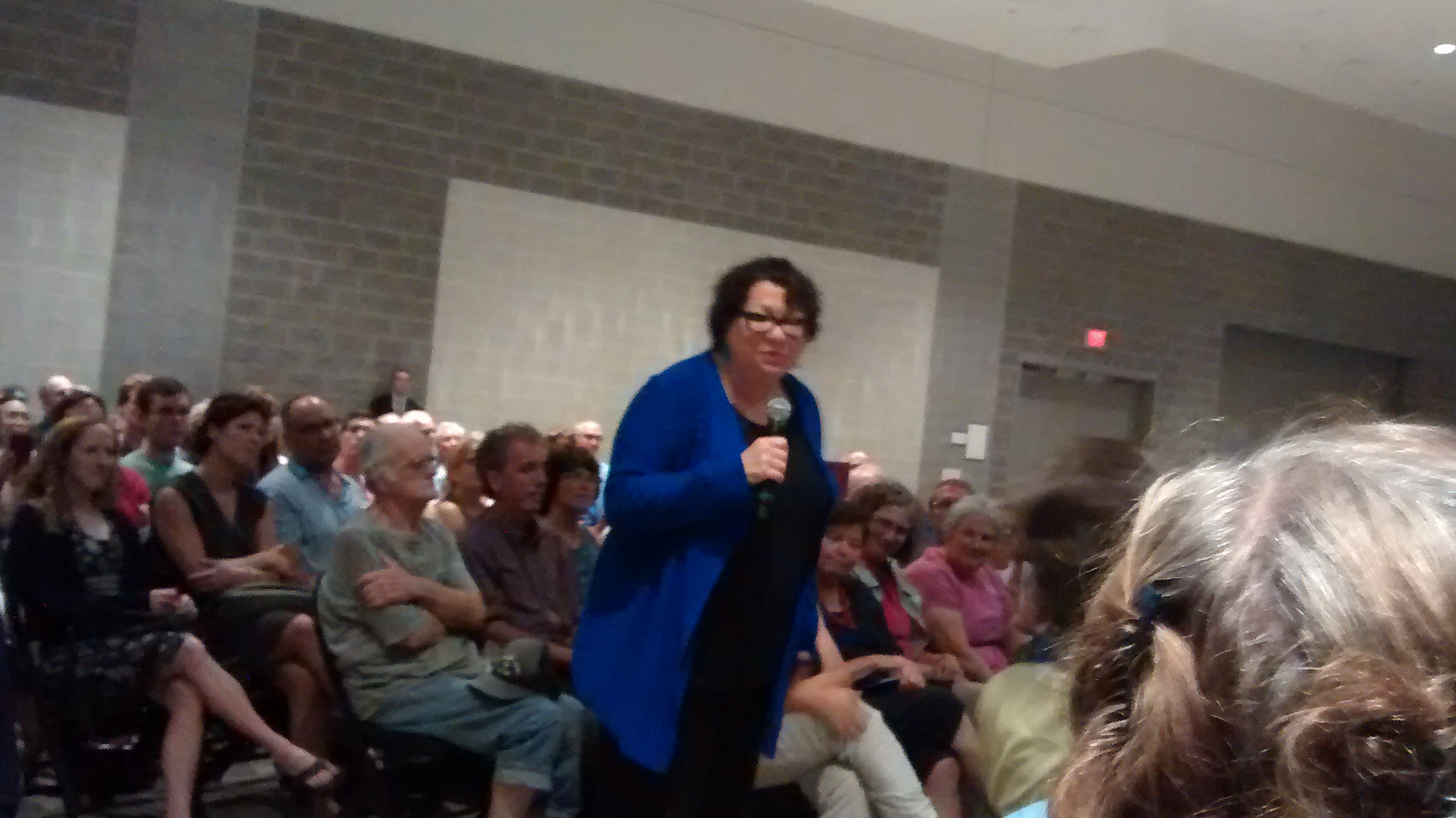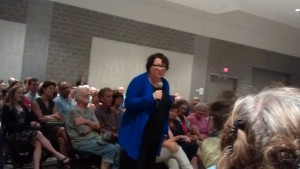Justice Sonia Sotomayor: Never Give Up Hope

By Shel Horowitz

Yes, you can be a United States Supreme Court Justice and still keep your humanity. In an hour and a half of Q&A at the Springfield Public Forum in Springfield, Massachusetts, Justice Sonia Sotomayor not only kept her content humble and hopeful, but did her best to make herself one with the audience.
She answered the first question from the stage, but then left her comfortable armchair, announced that she wanted to make herself more accessible to the people at the far corners of the room, pleaded with the audience not to do anything that would make the Secret Service agents too nervous to let her wander, and then answered all remaining questions while walking around the room shaking hands and getting photographed—and leaving the moderator (another female judge) gaping and wondering where her speaker was at times. I’ve certainly seen speakers mingle, but I’m not sure I’ve ever seen one who spent virtually the entire speech mingling. It’s especially remarkable in a government official; most of them stay firmly behind their podiums, clinging tightly. I can’t imagine Hillary Clinton doing that. But Sotomayor is like that; she spent her first weeks at the Supreme Court not just boning up on the then-upcoming Citizens United case but also visiting the far corners of the building and greeting the staff. She claims to be the first Supreme Court Justice to visit the telephone operators up on the third floor.
Hillary also probably has help writing her books. Sotomayor–like President Obama–writes her own, even as she acknowledged that writing didn’t come easily to her until a college mentor observed that she was thinking in Spanish (her first language) and translating.
Like Sotomayor, I grew up poor in the Bronx (and actually fantasized about becoming a social justice lawyer and eventually, a Supreme Court Justice—though I love the career I chose instead). And I was thrilled to hear her say things like:
- “I wanted to write a book that would give people hope…if I [the child of an immigrant alcoholic, raised in the tough housing projects of New York] can do it, so can you.”
- “Squeeze as much as you can out of every day. Give to others. Don’t take a moment to not live life at its fullest.”
- “Affirmative Action was a door opener for a door that had been closed to people of my background. Many institutions like to do the same thing over and over. But that success formula excludes certain people. The question is, what did I do with that opportunity? I wanted my career to be a bridge between my community and the wider society.” She noted that others had been given similar opportunity but chose not to make the most of it.
- “As a prosecutor, I learned how to seek justice not just for society but for the defendant.
- “Every mentor has made a positive mark on my life, and I hope that I have for them.”
- “Accept your limitations and your strengths.”
Surprisingly, when asked where in her career she had the most fun, she didn’t hesitate to respond “as a trial judge. Every day, you’re surprised! When I retire from the Supreme Court, I want to go back to it.” She misses the human contact with the plaintiffs and defendants, who are generally not present in appeals or Supreme courtrooms.
When asked why the greatest legal minds in the country have so many split decisions, Sotomayor pointed out that this is part of the Supremes’ mandate. “The case wouldn’t come before the Supreme Court if the answer was clear. We don’t take cases unless there are disagreements in the Circuit Court decisions. That’s why we have 5-4 decisions. It doesn’t mean that the four are wrong, but that the five thought another way. Some people say [the split decisions lessen their faith in government]. I hope the split means you have more faith in the government, because if everything is 9-0, we’re not taking the care we need to. And if there’s a [written] dissent, at least somebody heard you.”
Dissents, for her, are also cause for optimism. “We can write our dissents and hope to influence Congress or a future Supreme Court decision. You have to feel optimistic that things can change. You have to hold that hope, so you can let go” and accept being on the losing side. “I remain optimistic, despite what’s happening in Congress right now.
And she asks each of us to take responsibility, to do our part for a better world, even if it’s as simple as casting a vote or calling a loved one. “Whatever you do, do it with passion and caring. Not voting is the greatest act of being a traitor. What counts is caring enough to make your voice heard. Every day, I try to become a better person, a better Justice. How many of us forget to call a friend who’s sick or suffered a loss? Every day I try to remind myself that the world doesn’t revolve around me. Every night before you go to sleep, ask yourself these two questions:
- What have I learned that’s new today?
- What good have I done today?
“If you can’t answer those two questions, don’t go to sleep. Send someone a [‘thinking-of-you’] email. Go on Google and learn about something.
Known as a Justice who asks a lot of questions during oral argument, Sotomayor was asked if she often changed her mind based on the lawyers’ responses to the Justices’ questions. And she said that she changes her thinking based on the oral argument, though not necessarily her vote, about 20 percent of the time. To future lawyers in the largely student audience, she advised, “Be happy when we ask questions. We engage you in engaging us.” But she said often, the real benefit to her in oral arguments is from listening to the questions of her colleagues. “I see what road they’re going down, what they’re thinking.” The Justices don’t discuss cases before oral arguments, so these are the first insights she gets about a case’s direction.
In the past, the Court was a very contentious place, with some Justices not speaking to each other for years. That changed, she said, when Sandra Day O’Connor (the first woman Justice, appointed by President Reagan) came onboard. She insisted on building collegial relationships, through instituting several changes including a weekly lunch. “She made a huge difference. There’s an ethos now that if someone says something they shouldn’t have, they call and apologize.”
She chose law, she said, because “I wanted to guide people into making decisions that were fair to themselves and to other people.” It was a way to help people solve problems, and it did not require singing, dancing, or drawing, didn’t require the patience of a teacher, and did not involve medicine; as a diabetic since age 7, she felt she’d spent far too much time in hospitals to want to work in one. When the moderator shot back that Sotomayor was the best salsa dancer she knew, the 61-year-old Justice said she’d taken lessons at 50, when she got tired of being the only Latina she knew who didn’t dance. She asked her mother why she’d never been taught to dance as a child, and her mom replied, “You were always outside chasing fireflies. We could never get you to be still long enough.”
Her final advice was to remember the people who helped you and to overcome your fears. “Every job I’ve had, every obstacle I’ve overcome, I’ve been afraid. None of us gets anywhere in life without the help of others. Nobody accomplishes alone. We are each of us blessed with the good and the bad I hope each of you can appreciate the blessings in your world.”
Note: material in quote marks and not in brackets are as accurate as my notes, memories, and ability to decipher my scrunched handwriting allow (I had no paper so I was writing on the backs of business cards). I apologize for any transcription errors I may have made. Material within square brackets is paraphrased.

